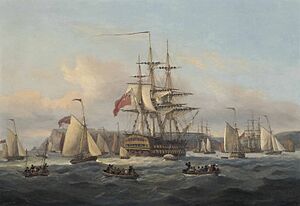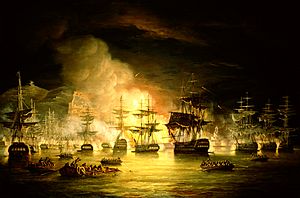Thomas Luny facts for kids
Thomas Luny (born 1759, died 1837) was a talented English artist. He was born in Cornwall, likely in a place called St Ewe. Thomas Luny was famous for painting pictures of the sea. These types of paintings are called seascapes. He also painted other works related to ships and the ocean.
Contents
Early Life and Learning to Paint
When Thomas Luny was eleven years old, he left Cornwall. He moved to London to start his art career. In London, he became a student of Francis Holman. Holman was a well-known marine painter. He taught Luny a lot about art. Luny stayed in Holman's studio until 1780. The studio was first in Broad Street, then moved to Old Gravel Lane.
First Travels and Exhibitions
In 1777, Luny took a break from his studies. He traveled to France. During this trip, he might have gone beyond France. His first painting shown in London that year was called A distant view of the island of Madeira and Porto Santo. This title suggests he might have seen an engraving that inspired him. It's also unlikely he was at the Battle of the Nile in 1798. He probably wasn't at the Bombardment of Algiers in 1816 either. However, he painted both events with great drama and realism.
Working as an Artist in London
After leaving Holman's studio in 1780, Luny moved to Leadenhall Street in 1783. Around this time, he often showed his paintings. He exhibited at the Royal Academy twenty-nine times between 1780 and 1802.
Meeting Mr. Merle
In Leadenhall Street, Luny met a person known as "Mr. Merle". Mr. Merle was a dealer and framer of paintings. He helped sell Luny's art for over twenty years. This partnership was very successful for Luny.
Painting for the East India Company
Luny also found many customers in Leadenhall Street. The British East India Company had its main office there. Officers from the company asked Luny to paint many pictures. They commissioned seascapes and portraits. This connection helped Luny in other ways too. He likely traveled as a guest on the company's ships. This allowed him to sketch places like Naples, Gibraltar, and Charleston, South Carolina. His paintings of these places show great detail and look very real.
Later Life in Teignmouth
In 1807, Luny decided to move again. He moved to Teignmouth in Devon. There, he continued to get many painting jobs. Most of his clients were former sailors and local wealthy people. He was just as successful in Teignmouth as he had been in London.
Painting with Arthritis
By this time, Luny was suffering from arthritis in both hands. This is a condition that makes joints stiff and painful. However, it did not seem to affect his painting. He kept painting at the same speed and with the same quality. In fact, he created over 3,000 paintings in his lifetime. More than 2,200 of these were made after 1807, until he died.
Death and Burial
Thomas Luny passed away on September 30, 1837. He was buried in the graveyard of St James' Church. This is the parish church of Teignmouth. His half-brother, Captain James Wallace, was buried there too. Captain Wallace had fought in the Battle of Copenhagen (1801) alongside Admiral Nelson.
Where to See His Art
You can see some of Thomas Luny's amazing paintings today. His works are displayed in several museums:
- The National Maritime Museum in Greenwich.
- The Royal Albert Memorial Museum in Exeter.
- The Mariners' Museum in Newport News, Virginia.




